Learn

Blood Groups
Take a minute and study the Table 1 which illustrates the antigens present by blood type. Also, note the last column of the table showing antibodyblood protein produced in response to a specific antigen/part of immunity presence in the plasma by blood type.
| Blood Type | Antigen Present on RBC Surface | Antibody Present in Plasma |
|---|---|---|
| A | A | B |
| B | B | A |
| AB | A and B both | None |
| O | None | A and B both present in plasma |
| Rh− | No Rh "D" antigen | D antibody present in plasma |
| Rh+ | Rh "D" antigen is present | No D antibody |
You will be applying this knowledge later in a blood transfusionThe process of transferring the blood of a person into the veins of another. simulation lab.

ABO Blood Types
Let's get a better understanding of blood types and transfusion compatibility by breaking these concepts down into chunks. We will focus on ABO blood types and then Rh types.
If you have the "A" antigen on your RBC surface, you will be told you have Type A blood.

Type A blood will have "B" antibodies in the plasma. This is how your body recognizes and protects you from any foreign invading blood types.
- If Type A receives Type B blood, an attack will be activated.
- The "B" antibodies in the plasma of the Type A blood will attach to, and activate the destruction of all cells containing "B" antigens on their surface (Type B blood).
- Look again at Table 1 paying attention to Blood Type A row.
Could you imagine what would happen if you were low on blood and then given the incorrect blood type? Your antibodies would attack the invading blood, and a reaction called agglutination, or the clumping of blood, would occur, possibly resulting in death. This is why blood transfusions require the correctly matched blood type.

![]() Check your understanding...
Check your understanding...
1. Now, notice in Table 1 (below) that Type O blood does not have any "A" or "B" antigens, but has both "A" and "B" antibodies. What implication would the absence of A and B antigens have in relation to blood transfusions?
| Blood Type | Antigen Present on RBC Surface | Antibody Present in Plasma |
|---|---|---|
| A | A | B |
| B | B | A |
| AB | A and B both | None |
| O | None | A and B both present in plasma |
| Rh− | No Rh "D" antigen | D antibody present in plasma |
| Rh+ | Rh "D" antigen is present | No D antibody |
2. Taking that concept and applying it to Type AB blood, what can you say about blood transfusions?
Take a moment to review the ABO blood types by viewing Table 2. This table illustrates ABO blood type differences with representations.
| Group A | Group B | Group AB | Group O | |
|---|---|---|---|---|
| Red Blood Cell Type | 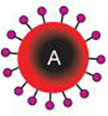 |
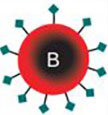 |
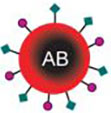 |
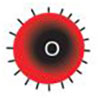 |
| Antibodies in Plasma |  |
 |
 |
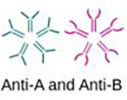 |
| Antigens in Red Blood Cells |  |
 |
 |
 |

Rh Blood Types
Now, let's look at the Rh blood type. Table 3 shows the antigen and antibody information with this group.
| Blood Type | Antigen Present on RBC Surface | Antibody Present in Plasma |
|---|---|---|
| Rh− | No Rh "D" antigen | D antibody present in plasma |
| Rh+ | Rh "D" antigen is present | No D antibody |
- If this antigen is on your cell surface, you are positive for it and considered Rh+.
- If this antigen is NOT present, you are negative for it and considered Rh−.
- Someone who is Rh− has antibodies to attack Rh+, while a person who is Rh+ does not.
- All blood types are either Rh+ or Rh− and it is noted with a positive or negative sign by the blood type name. (example: Type A+ or Type A−)
Interesting Fact: O+ is the most common blood type while AB− is the least common in the United States!
![]() Check your understanding:
Check your understanding:
3. What blood type do you have if the following conditions exist: Your RBCs do not have any antigens present, and your plasma has A and B antibodies.
4. What would happen if someone having Type B+ blood was transfused with Type B− blood?
5. Would a person with the blood type mentioned above be able to receive Type AB+ blood without a problem and why or why not?

